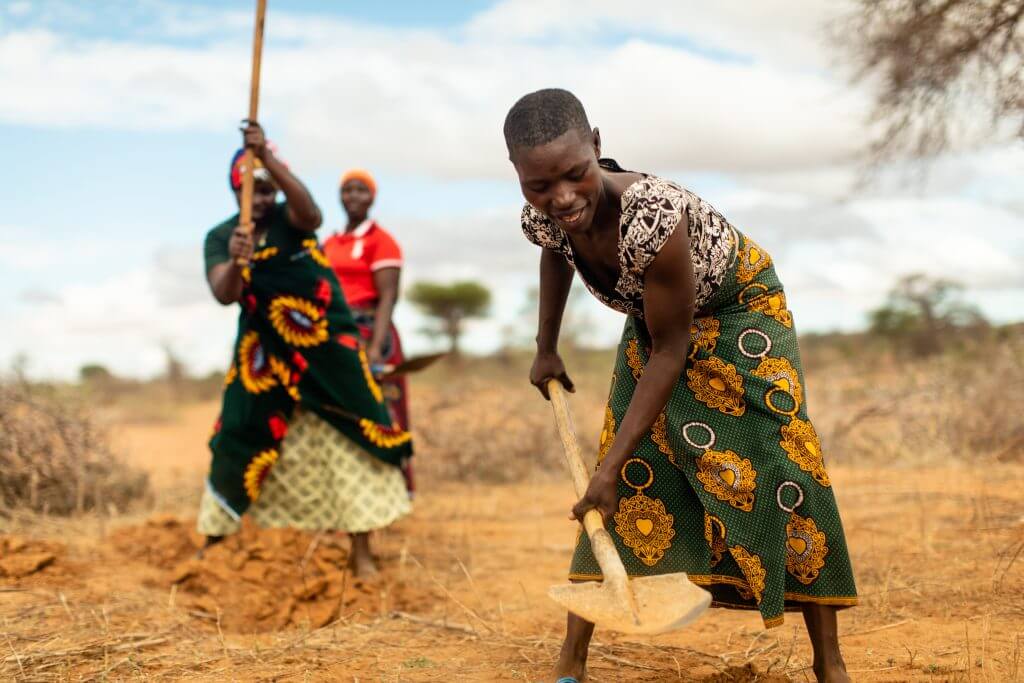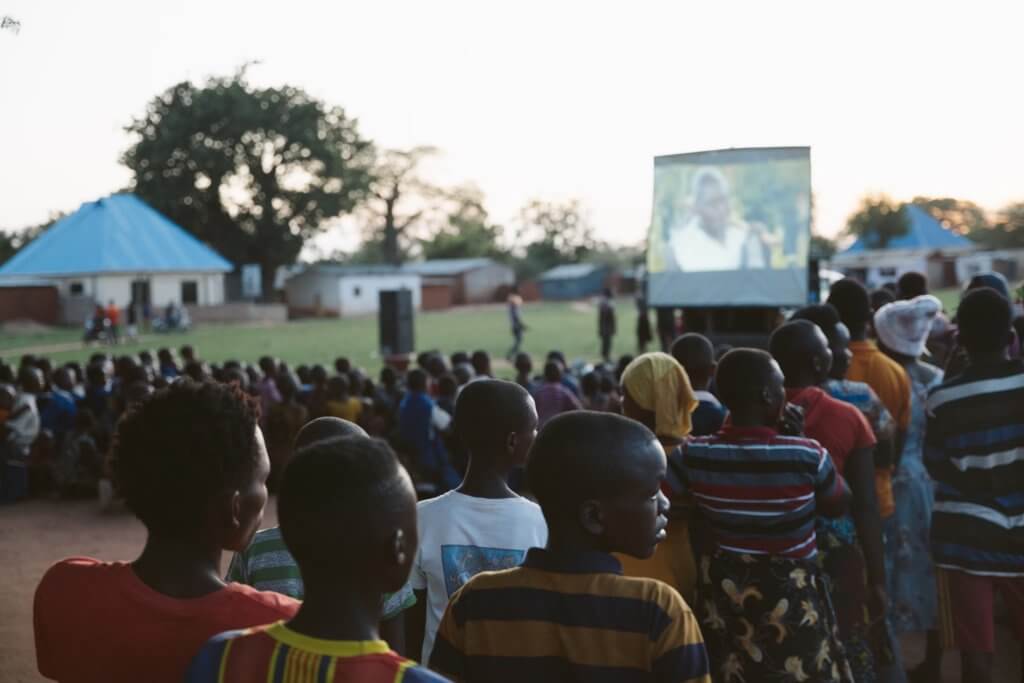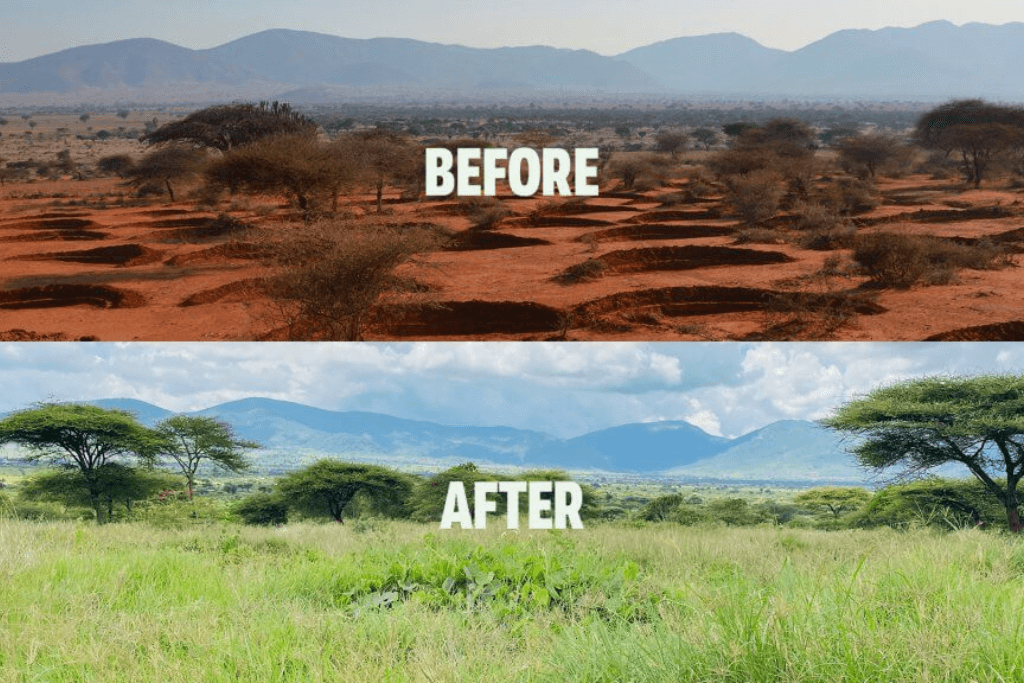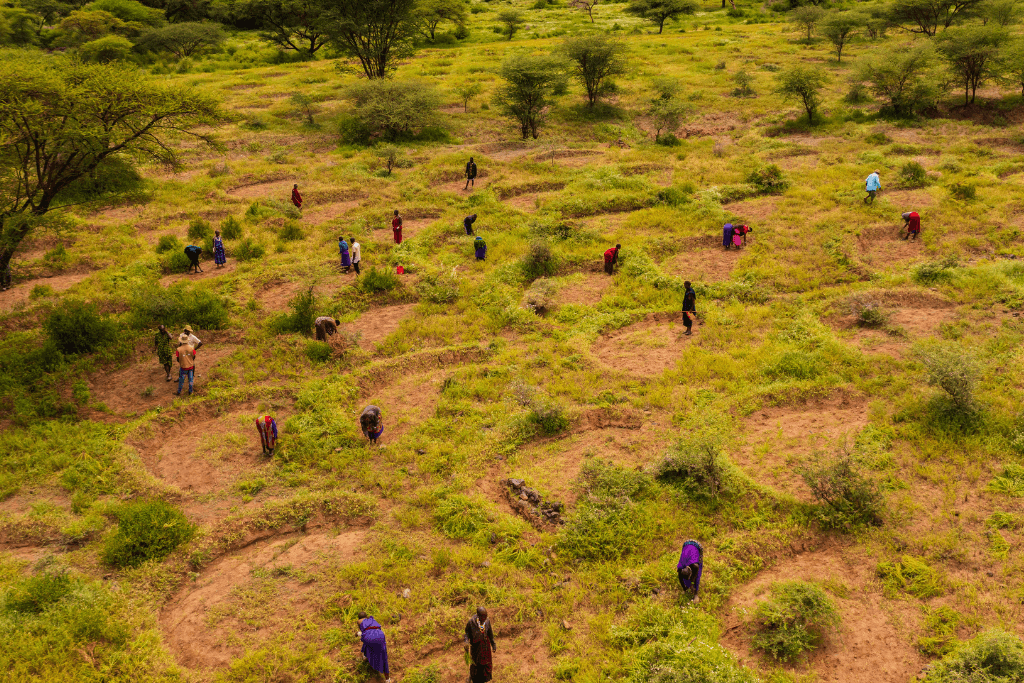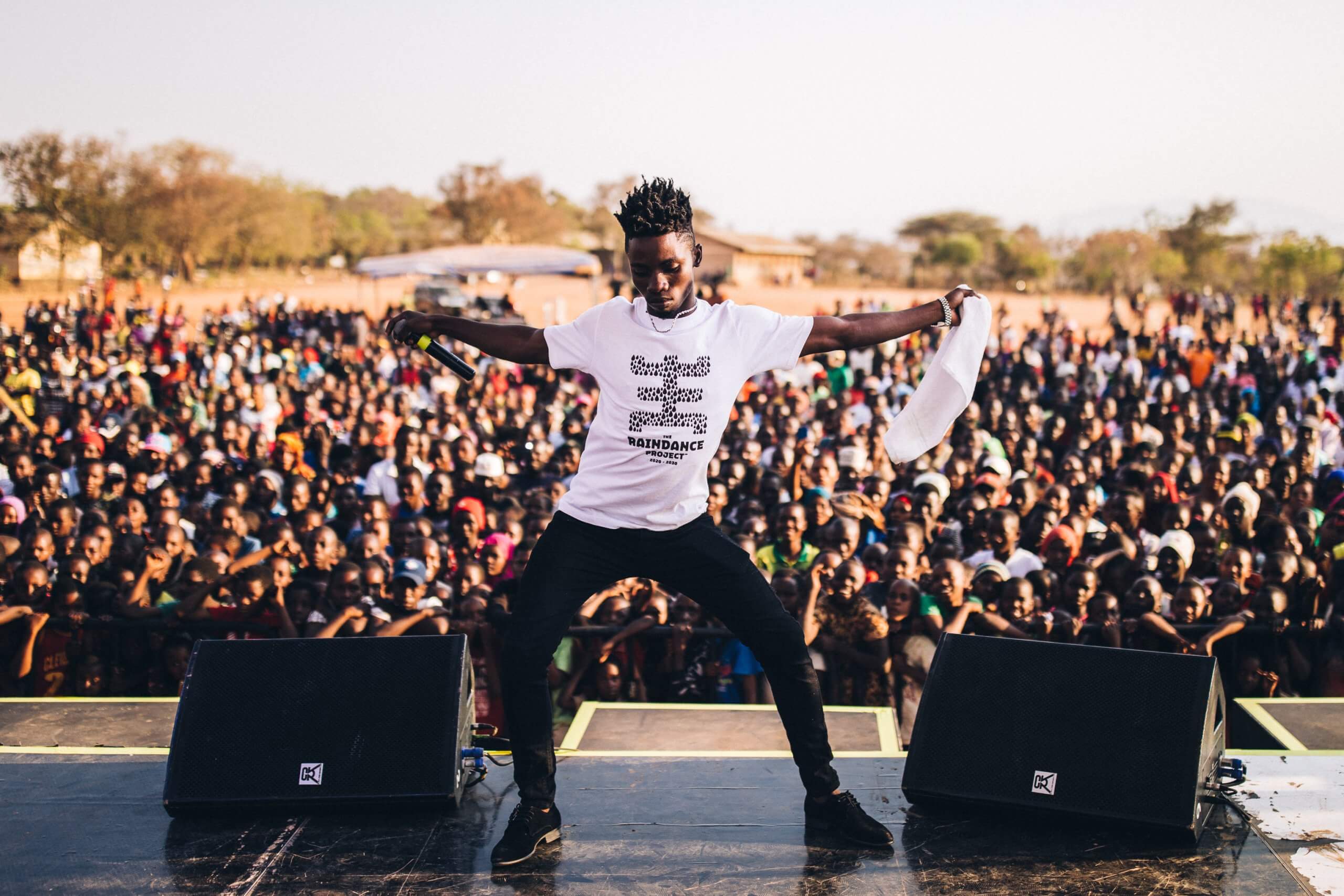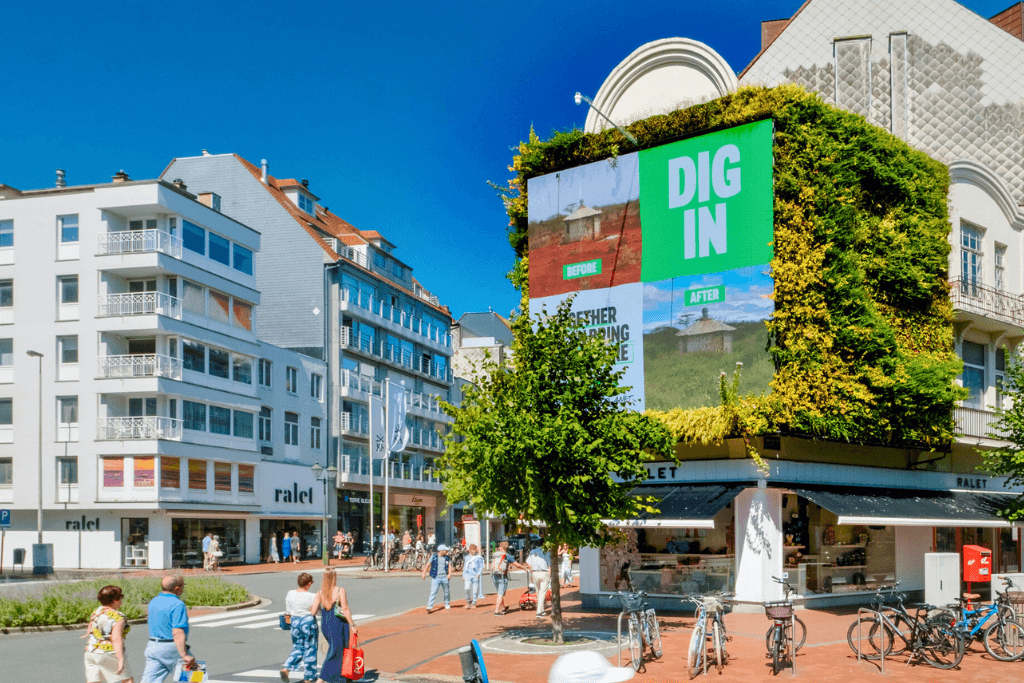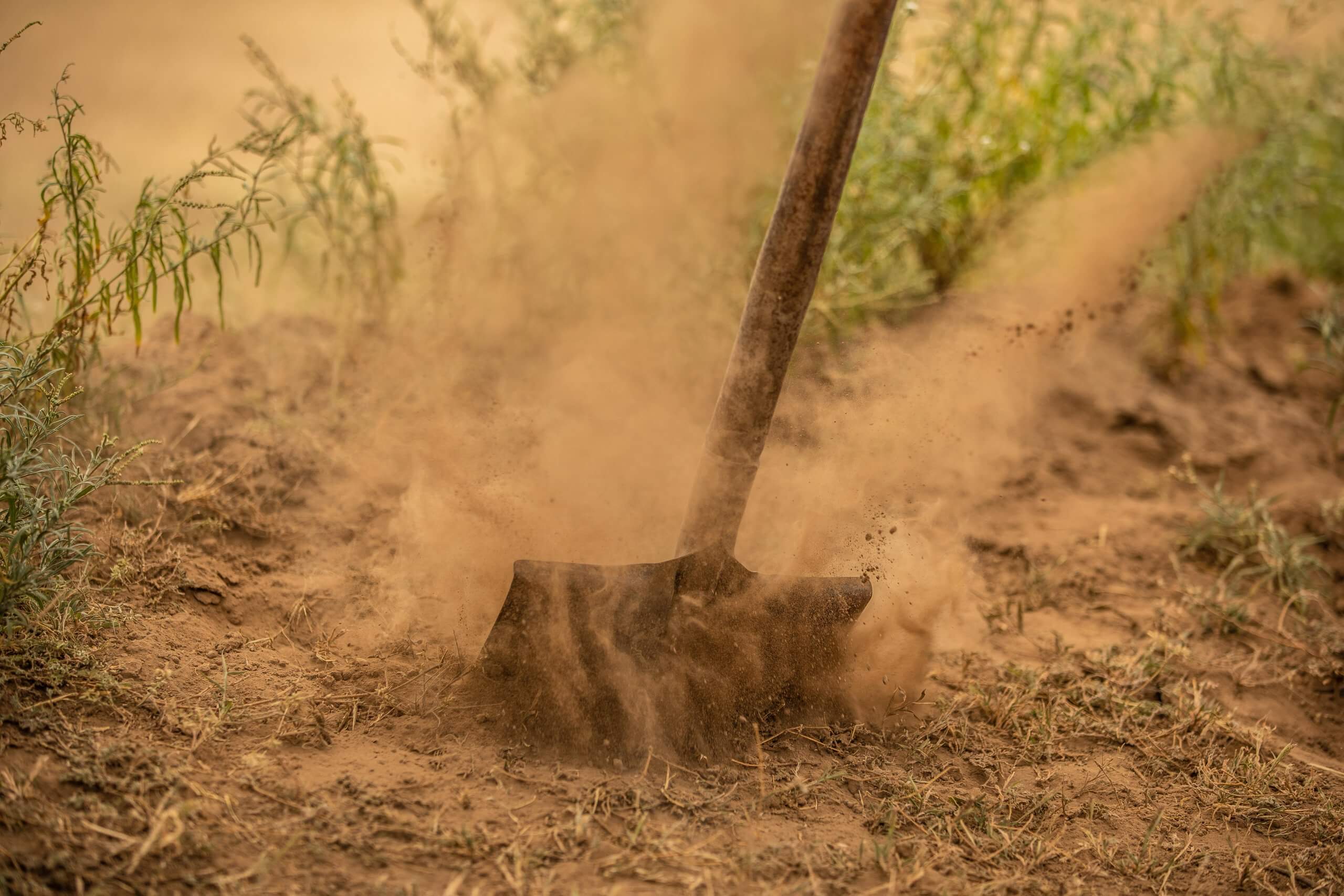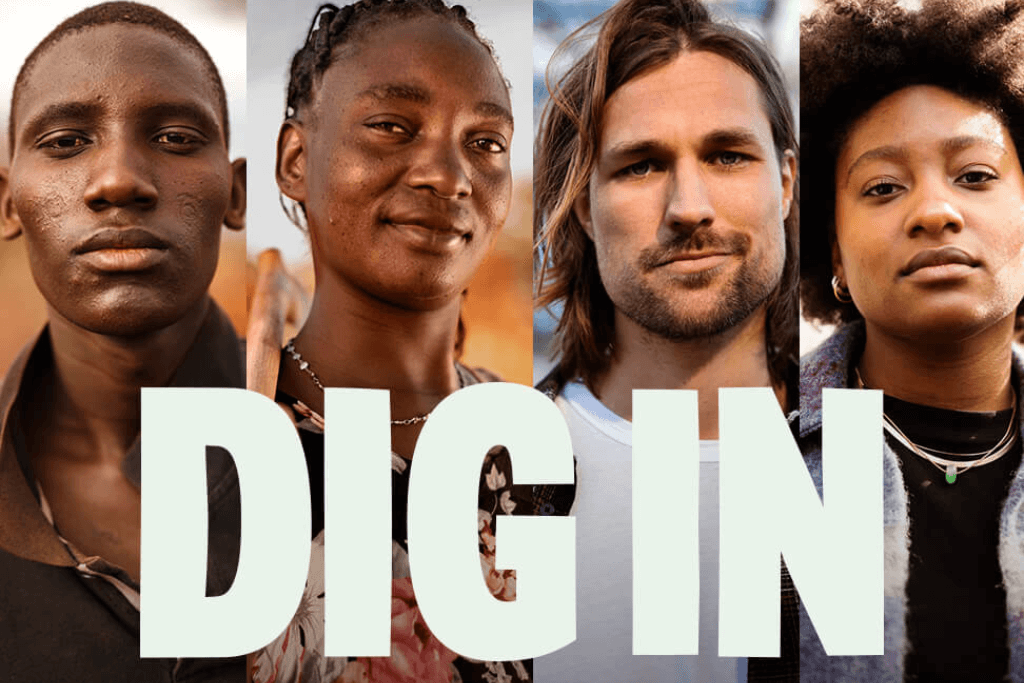FAQ
General
How did Justdiggit start?
Justdiggit is the new name for the former NAGA foundation. The organisation was founded in 2009 by Peter Westerveld and Dennis Karpes. Our goal is to restore and regreen degraded landscapes, increase biodiversity, and have a positive impact on the climate. Together we can make the planet green and cool again!
Why is Justdiggit regreening?
Global warming, overexploitation of farmlands, cutting down trees and overgrazing of grassy areas cause the soil to dry out. This drought leads to desertification and degradation of the land, making it hard to obtain food, crops, fresh water and natural resources, such as firewood, from the land. Especially in vulnerable areas, such as Sub-Saharan Africa, the consequences of the drought are felt on a daily basis. However, there is a solution: regreening! Vegetation causes the sequestration of carbon, decreasing the amount of carbon in the atmosphere and subsequently reducing the greenhouse effect, ultimately leading to the mitigation of global warming. Vegetation also causes cooling of the soil, decreasing the evaporation of water from the soil leading to increased water availability for plants, animals and humans. In addition, regreening stimulates the water cycle, causing increased rainfall and the retention of water in the soil. Eventually, regreening can make the land available again for agriculture, natural sources and water supplies.
Our regreening techniques
Which regreening interventions are used by Justdiggit?
Justdiggit uses various techniques in order to bring back vegetation within degraded areas. The farmers in Tanzania are busy with a technique called Farmer Managed Natural Regeneration (FMNR), also known as Kisiki Hai in Swahili. It helps the farmers to regrow felled trees. In our educative documentaries you can learn how this exactly works: Kiski Hai I & Kisiki Hai II. Within Kenya, the women and men of the communities dig water-bunds to harvest rainwater and develop so-called olopololis: grasslands which are protected to prevent overgrazing by livestock. Curious about how these techniques exactly work? Take a look at our work pages!
Does Justdiggit use their own regreening techniques?
The traditional regreening techniques we apply in our project areas have been used for centuries. So we did not invent them ourselves. However, to increase the impact of our landscape restoration activities, we apply new technologies and science. Therefore, before we start regreening, we examine the soil, the amount of rainfall, the amount of seeds in the soil, and whether the area is located on a slope or not.
We developed a platform called Greener.LAND. On this platform, you can find information on several regreening techniques. They are described in detail, including an explanation of how to do it yourself. Based on the soil type, it will recommend you which regreening technique is best suitable for your landscape.
Is regreening based on science/ is there independent information about your regreening techniques?
Yes, our regreening techniques are scientifically proven. Justdiggit works together with The University of Wageningen and we have got an in-house geo-hydrologist. Wageningen University mainly focuses on ‘healthy food & living environments’. Restoring degraded soil to make it green and fertile again is part of this as well. Before we start regreening an area, we determine together with our scientific and local partners which technology is best for that area to maximize our impact
Does Justdiggit also plant trees?
Justdiggit does not plant trees in the project areas, however: we bring trees back! In the past, there used to be many trees within these areas. Though, most trees have been cut down in order to be used as firewood or to make room for agriculture. The roots of many of these trees are still alive, causing the stumps of the trees to live like a kind of bush. We teach the farmers to make use of a technique called Farmer Managed Natural Regeneration (FMNR), or Treecovery / Kisiki Hai (‘living stump’ in Swahili). This technique helps to regrow the felled trees by pruning the bushes in a specific way and supports new, naturally occurring sprouts to grow big. Trees prevent drying of the soil since their roots can increase the retention of water in the soil. Besides, the shadow of the trees helps to decrease the soil temperature, reducing evaporation of water from the soil. Due to the enhanced water availability in the soil, more regreening will take place. Want to know more about this technique? Take a look at our work page!
Can digging bunds have any negative effects?
Before starting to dig the bunds, we first examine the soil. The method of digging bunds preserves existing vegetation and/or root systems. Additionally, we work in areas where the soil has degraded to such an extent that little grows or lives. Thus, digging bunds has few negative effects. We can never rule it out completely, but the positive effects far outweigh the negative!
What size are bunds?
The size of bunds differ from location and surroundings but below you can see the average size we use:
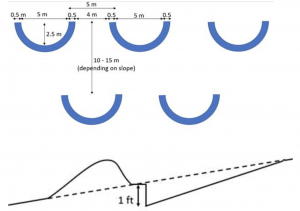
Another fun fact about bunds: one bund can regreen an area of 124m2. Besides that it can also hold about 2100 liters of water when it is full!.
Does Justdiggit also plant vegetation?
When digging the bunds, we sometimes add some grass seeds to speed up the process. The purpose of this is not to grow crops but to give nature a little boost, speeding up the regreening process. Doing so creates additional advantages automatically, such as food security.
What is the difference between Justdiggit's regreening interventions and permaculture?
Permaculture is a broad concept. It focuses on creating a living environment in which humans can live from nature while healthy ecosystems are developed or maintained. Restoring degraded landscapes, as a consequence of human activities, is a part of this. Since permaculture includes much more than only the restoration of degraded landscapes, we prefer not to use this term when describing our projects. It is important to clarify what we are doing, why we are doing it and what the effects are.
Why doesn't Justdiggit use machines?
We consciously choose to use a shovel instead of machines or robots when digging bunds. This way we want to make the techniques as accessible as possible for the people carrying out the projects.
It also keeps the projects low-budget. This way we try to stimulate and inspire other communities to start re-greening: all you need is a shovel to make your area greener and more fertile again! We offer a long-term and sustainable solution that can easily be expanded. By involving the local communities in the projects and giving them ownership, we also ensure that the projects are sustainable. In our projects in Kenya, they are also paid for the work they do, which gives socio-economic benefits.
Besides the shovel, we also use other techniques that local communities and farmers can easily apply themselves. Here you can read more about these techniques.
Our projects
What is the impact of Justdiggit's projects besides regreening degraded land?
Regreening degraded land has a positive impact on the environment, as it helps to cool down the soil, helps water to infiltrate into the soil, sequestrates carbon and increases the presence of organic matter and nutrients in the soil, promoting the growth of vegetation. But besides these environmental benefits, our projects also have a positive impact on other aspects.
Socio-economic benefits:
Bringing back vegetation has a positive effect on local communities and their livelihoods. The projects lead to healthy pasture lands and increased crop yields, leading to increased income for the communities.
Biodiversity:
Our regreening projects also have a positive impact on the local biodiversity. By bringing back vegetation and restoring ecosystems, we improve the living environment for many different animal and plant species. With more water and food availability, we see an increase in biodiversity among plants, insects, birds and wildlife in the areas that have been regreened.
Why are Justdiggit's projects only located within Africa?
Drying and degradation of the land is a global problem. Especially in vulnerable dry areas, it can have serious consequences. Regions in Africa, the Middle-East, North-America and South-Asia are under great pressures (source: Exploring future changes in land use and land conditions and the impacts on food, water, climate change and biodiversity). The population in these areas is growing faster in comparison with other areas, making available land and water scares. Since we think it is important to make the impact of our projects as big as possible, our projects are located in the continent with one of these most degraded areas: Africa. Every area is different and thus need a specific method of regreening. This is why Justdiggit chose to specialise in regreening ecosystems within Africa. In this way we are remaining our focus and we can make sure the best regreening techniques are used.
65% of the land in Africa is affected by degradation, leaving a lot of space for regreening. The urgency of regreening in Africa is high. Drought and degradation of the land cause crops failure, causing hunger and poverty within these areas. Besides this, the regreening in Africa not only has a positive impact on nature, also the local communities and animals are positively influenced. Do you want to know how? Take a look at our what we do page!
Can I visit the project areas?
At Justdiggit, we want everyone to know about the amazing benefits and great potential of nature-based solutions for the regreening and cooling of our planet. Unfortunately, it is not possible to visit our project areas. Our projects are entirely carried out by local partners and the community. Additionally, our projects take place on both private and communal land. Thus, we cannot facilitate visits to our project areas.
However, to truly understand how these simple interventions transform entire landscapes, ecosystems and communities, you have to see it with your own eyes. And that’s where we run into a problem: we can’t transport the entire world to our project areas.
We decided to bring our regreening projects directly to you – with our new interactive experience! Using your computer, smartphone or tablet, you can now immerse yourself in the daily life at our project sites. You will experience the gifts of nature, explore the great potential of large-scale, community-led regreening, and feel the beating heart of one of the most ambitious regreening movements in Africa – as if you were right there with us.
Does Justdiggit have any projects outside Africa?
Our current plans do not include starting a project outside of Africa soon. In other parts of the world degradation of the land is a big issue. However, at this stage we have to choose what areas to focus on and we decided to specialize in regreening ecosystems within Africa only. This way we can make sure the best regreening techniques are being used for that particular area.
But there is good news: we do encourage and provide building blocks for others to follow our lead! On our platform Greener Land, you can find the perfect regreening technique for all types of landscapes! After choosing the characteristics of your land, the website will tell you which techniques will work best for you. Then, it will tell you how to apply this technique in the best way. Our hope is that this inspires others to get a regreening movement started!
How does Justdiggit ensure sustainability within your projects?
Our projects are entirely carried out by local partners and the locals. This makes them committed and gives them ownership of the project, which ensures sustainability of the projects. In Kenya, we pay local communities for their work, which provides socio-economic benefits within the local devices.
These projects take place on both private and communal land. In Tanzania, we teach farmers to make their land as green and fertile as possible. In Kenya, the projects take place on communal land and it is a joint effort of the communities that live there.
Our goal is not only to regreen, but also to emphasize the importance of the regreening techniques. This way, farmers will know how important it is to keep on regreening and spread the message to others.
Of course, this mindset change takes time. That is why we work together with local partners who oversee the projects on the spot, and make sure that the regreened areas remain green! We work with rangers in Kenya, for example. They guard our fenced grass seed banks. In Tanzania, we work with certified farmers who apply our techniques and pass them on to other farmers, or as we like to call them: ‘champion farmers’.
Does Justdiggit buy the land on which you regreen?
We do not buy the land that we are regreening. Our many regreening projects operate in African countries. In Kenya, for example, the Maasai work on communal land; their own land. They do this together with local organizations. And in Tanzania, we encourage people (farmers) to regreen on their own land.
Do Justdiggit's projects really make a difference for climate change?
Justdiggit is working in several project areas on the regreening of degraded land. Growing back vegetation (plants and seeds) has multiple positive consequences. First of all, vegetation functions as airconditioning of the planet. By sequestering large amounts of carbon, the carbon in the atmosphere decreases, which has a global cooling effect. In fact, research shows that regreening projects like ours do contribute up to 37% of the carbon emission intake to keep global warming below 2 degrees Celsius (A link to more information on nature-based climate change solutions). Moreover, vegetation cools down the soil. As a result, less water evaporates from the soil, so there is more water available for the plants.
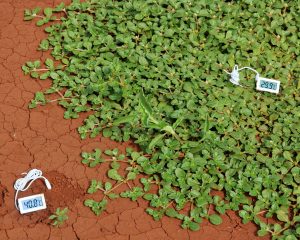
Check out this huge temperature difference on this farmland! The degraded soil is 40.8 degrees Celsius, while the green part is 29.9 degrees.
Additionally, vegetation causes an increase in humidity. Vegetation evaporates water, which results in more moisture in the air and stimulation in the formation of clouds. This increases the chance of rain as well! This way, we can restore the natural water cycle, and more rainfall ensures further recovery of the vegetation and the ecosystem.
Although we are very motivated to expand our projects, we also encourage other regreening projects. This way, we can increase the global impact and change the climate positively together! Therefore, global awareness of this matter has to grow to have a bigger impact.
Can I start my own regreening project?
Want to start regreening yourself? Cool! Together we can create a greener and cooler planet, and starting your own regreening project will definitely contribute to that cause!
We developed a platform called Greener.LAND. On this platform, you can find information on several regreening techniques. They are described in detail, including an explanation of how to do it yourself. Based on the soil type, it will recommend you which regreening technique is best suitable for your landscape. Hopefully, this can get you started.
Drought
Rain and drought often exist next to each other, how does this work?
Within dry areas in Africa, the amount of rain is often just as much as the amount of rain in for example the Netherlands. What is the reason that the soil is still being really dry? When rain falls in Africa, it is often in short and intensive showers. The water does not have the time to infiltrate into the soil. It washes away, taking the upper fertile layer of the soil with a process called erosion. Because the water does not infiltrate into the soil, the moisture within the soil decreases, causing desertification and degradation. A green and healthy ecosystem can become a dry and arid area where only few plants can grow and humans and animals struggle to survive.
Carbon
The sequestration of carbon, how does this work within Justdiggit?
It is good to know Justdiggit formally does not ‘directly’ compensate for carbon. However, by regreening degraded landscapes, we do support the sequestration of carbon. To compensate carbon in a formal way, specific certification of the sequestrated carbon is needed. The set up of such a certification project takes multiple years and is relatively expensive (up to several million dollars). As we want to make a big impact in a short amount of time, we decided to remain focused on our primary mission: regreening millions hectares of degraded land within Africa, positively benefitting nature, biodiversity, humans and the climate.
How does Justdiggit contribute to the sequestration of carbon?
A regreened area can, during a period of 20 to 30 years, make sure more carbon is sequestered than emitted. The amount of carbon sequestration in such a regreened area is depending on the type of regreening intervention used and the type of vegetation recovered within a specific area. The farmers in Tanzania are busy with a technique called Kisiki Hai, which enables the farmers to bring back felled trees. Within Kenya, the communities are exhibiting various regreening methods, such as digging water-bunds. By supporting our regreening projects in Africa, you not only help to regreen degraded landscapes, but also make sure the amount of carbon is decreased. Want to know more about our projects? Take a look at our work pages.
How does the sequestration of carbon work within the regreened areas?
Vegetation can sequestrate carbon from the atmosphere by a process called photosynthesis. The carbon is converted into sugars, providing plants and trees energy to grow. The process of photosynthesis takes place within so-called chloroplasts. These chloroplasts give the plants their green color. The more of these chloroplasts are present within an ecosystem, the more the process of photosynthesis will take place, increasing the sequestration of carbon from the air (source: Groenere planten, meer CO2 opslag). As you can imagine, the greener the area, the more carbon will be sequestrated.
Why is carbon sequestration important?
Accumulation of carbon in the atmosphere is the major cause of the current global warming. This is due to the so-called greenhouse effect. Greenhouse gasses such as carbon, prevent the heat of the earth to escape, causing warming of the earth. Global warming has several (severe) consequences. Especially in vulnerable areas, such as Sub-Saharan Africa, the consequences of climate change are felt on a daily basis. Extreme heat causes drought, leading to crops failure. When rain does arrive, it is often very intense, leaving no time for the water to infiltrate into the ground. It floods to lower areas, washing away the fertile top layer of the soil, a process called erosion. It leads to degradation of the land, making it hard to grow crops, causing a decline of vegetation and maintaining the land to be dry. Ultimately it can lead to poverty and famine in these areas.
Media
I often see Justdiggit on billboards, digital screens, television and in the cinema. How does this work?
Justdiggit cooperates with various “renowned” media partners. They help us with the creation, production and (online) distribution of our campaigns. Additionally, they support us with free media space. You can think about a commercial in the cinema or on television, but also our campaign screened on digital screens of billboards located on buildings. With help of this media space we were already visible in many European countries! But showing our impact on the site of our regreening is even more important: Africa! Many billboards are visible on the streets in Tanzania, radio spots are aired on the Tanzanian radio and we are broadcasted on local television. This is also completely sponsored by our (international) media partners. Want to know more about our campaigns? Check our campaign page!
Support
I want to support Justdiggit. How can I do this?
Amazing that you want to support us!
As for becoming more involved within our regreening movement, you could start by supporting us in spreading our story in various ways. You could share our story on (social)media and within your network, for instance. Or you could organise/be a part of an event, promote our bundtool within your network or do something else to create awareness about Justdiggit. Perhaps you have ideas of other ways or initiatives in which we could work together?
Besides spreading our story you can also donate! There are two ways to donate:
- Our bund tool
Via this tool, you can specifically donate to the regreening technique called bunds. One bund is only 8 euros. After you have bought your bund, the local farmers in Kenya will start digging. You will receive a personalised bund certificate. It’s either with your name on it, or with the name of the person you have gifted bunds to. We will keep you updated on the latest regreening news via different emails. - Our donation page
You can also donate via the donation page on our website. This donation will be divided over all our projects. Thus, your donation can be used to bring back trees in Tanzania, and/or it can sponsor the women’s grass seed project in Kenya. We cannot specify what every cent of your donation is being used for, but I can guarantee that – with your donation – hundreds of square meters are going to be regreened and thousands of litres of water will be stored. The impact that this has on water and food security, livelihood, biodiversity, and of course on the climate is huge!
What’s the difference between buying bunds on the Regreening platform and a ‘regular’ donation?
There are two ways to support our regreening projects. First, you can invest in your own water bunds through our bund tool. On this platform, you can purchase a bund for just 8 euros. The price structure can be found through this link. After you bought the desired number of bunds, local farmers in Kenya will start digging. You will receive bund updates via your email address to stay up to date with the latest regreening news! If you have questions regarding the bund tool, you can contact bunds@justdiggit.org.
Additionally, it is possible to donate ‘regularly’ as well. This donation can be made through the donation page on our website and will be divided over all our projects. This can be in either Kenya or Tanzania. An overview on the detailed distribution can be found in our recent annual report. We publish our annual report by the RJ 650 standard, which shows complete transparency on how we spend our funds.
How do I invest in a bund?
Besides ‘regular’ donations, it’s also possible to invest! For only €8 you invest in a bund, that supports re-greening and a Kenyan farmer. How does this work?
- Use our bund tool and choose if you want to buy a bund for yourself, or if you would like to give it away as a personal or business gift
- Choose the amount of bunds you would like to buy (up to a maximum of 50)
- After buying bunds, you will receive a personalised bund certificate. It’s either with your name on it, or with the name of the person you have gifted bunds to
- After buying your bunds you will receive bund updates via your email address to stay up to date with the latest regreening news!
If you have questions regarding the bund tool, you can contact bunds@justdiggit.org.
Curious about the price structure of the bunds? Click here
Can I make a monthly donation?
It is possible to do a monthly donation to our projects automatically! The difference by donating through our regular donation page on our website, you support all our regreening projects. This donation will be divided over all our projects. Thus, your donation can be used to bring back trees in Tanzania, and/or it can sponsor the women’s grass seed project in Kenya. We cannot specify what every donation is being used for, but we can guarantee that – with your donation – hundreds of square meters are going to be regreened and thousands of litres of water will be stored. The impact that this has on water and food security, livelihood, biodiversity, and of course on the climate is huge!
How can I stay informed about the bunds I bought or the donation I made?
It is possible to stay informed and get updates on the bunds you bought. You will receive bund updates via your email address to stay up to date with the latest regreening news!
If you have donated through our regular donation page, your contribution has gone to all our regreening projects in Africa (not to bunds specifically). This donation will be divided over all our projects. Thus, your donation can be used to bring back trees in Tanzania, and/or it can sponsor the women’s grass seed project in Kenya. We cannot specify what your donation is being used for, but we can guarantee that – with your donation – hundreds of square meters are going to be regreened and thousands of litres of water will be stored. The impact that this has on water and food security, livelihood, biodiversity, and of course on the climate is huge! If you want to stay up to date on all our projects, you can subscribe to our newsletter.
How come there is a different account number on the website than when I donate on the Regreening platform?
We totally understand your confusion. Donations via the donation page on our website are hosted by an online payment system called Mollie. Therefore, Mollie has a different account number than we do. All donations that go through Mollie (thus, our donation page) are deposited into our account.
What is the number of square meters I can regreen with the help of my donation?
This depends on the project and the regreening interventions. Since each intervention requires its own specific approach and maintenance, it is hard to determine how many square meters will be regreened with the help of your donation. Digging water bunds requires a lot of energy and time, but when they are dug, the regreening comes naturally. The grass seed banks require more maintenance, since the grass needs to be sowed and harvested every year. In case of Farmer Managed Natural Regeneration (FMNR), the costs are not in developing or maintaining the intervention, the farmers are performing the technique themselves. The costs are in training champion farmers and spreading knowledge of the technique amongst the farmers.
How can I change or cancel my donation?
First of all, we want to thank you for your support lately!
Do you want to keep regreening and cooling down the planet, but via a different bank account number? We would like to ask you to contact Justdiggit via finance@justdiggit.org. Because we cannot change your direct debit for security reasons, we will stop the current direct debit and ask you to start the new recurring donation. This is possible via the donation page or by setting up a direct debit via your bank to account number NL95 TRIO 0320 9718 13 in the name of Stichting Justdiggit Foundation.
To cancel your monthly donation, please also contact us via the above details. The information we need from you is the name on which the donation is known to us and the last 4 digits of your bank account number for verification. Then we will delete your direct debit from the payment system and we will send you a confirmation.
Can I give bunds to someone?
You certainly can! Bunds are the coolest gift you can give to someone. Through the bundt tool for giving a green gift, you can select how many gifts you want to give and how many bunds per gift will be on there. Next, enter the name of the recipient and then fill in your personal details. This will appear on the personalised certificate. Have fun giving!
If you have questions regarding the bund tool, you can contact bunds@justdiggit.org.
How much of my donation will actually go to regreening?
That’s a valid question!
We have two forms of donation:
Our bund tool
On this platform, you can specifically donate to the regreening technique called bunds. After you bought the desired number of bunds, local farmers in Kenya will start digging. Once your bund(s) have been dug, the farmer receives money. Within this project, 90% of your investment goes to the project. The remaining 10% goes to international transaction costs, which we cannot ignore, unfortunately. The detailed price structure can be found through this link.
Our donation page
Additionally, it is possible to donate ‘regularly’ as well. This donation can be made through the donation page on our website and will be divided over all our projects. Thus, your donation can be used to bring back trees in Tanzania, and/or it can sponsor the women’s grass seed project in Kenya. We cannot specify what every cent of your donation is being used for, but we can guarantee that – with your donation – hundreds of square meters are going to be regreened and thousands of liters of water will be stored. The impact that this has on water and food security, livelihood, biodiversity, and of course on the climate is huge! An overview of the detailed distribution can be found in our recent annual report. We publish our annual report by the RJ 650 standard, which shows complete transparency on how we spend our funds.
How will my 'regular' donation be spent?
Would you like to contribute to a greener and cooler planet through a donation? That is possible! With your (one-off, monthly or annual) donation you support our greening projects in Kenya and Tanzania. This donation will be divided over all our projects, so it’s spent where it is most needed at that moment. In our annual reports you can read more about how the donations have been spent in recent years.
Can I compensate for my travel CO2 emissions through Justdiggit?
Fantastic that you want to compensate for your CO2 emissions!
It is quite difficult to calculate and connect a specific price for the absorption of a ton of CO2. In our project areas, we use different types of regreening techniques, each of which ultimately results in various amounts of CO2 absorption. This is why we cannot provide one price to compensate for your own CO2 emissions.
Can I receive Justdiggit flyers or posters?
Amazing that you want to spread our story! Your support helps us to reach even more people and make them aware of the fact that together we can make the earth greener and cooler again. Unfortunately, we don’t have any flyers or other printed media that we can share with you- because save the trees! We try to do everything digitally to avoid paper waste. We can send you video/photos or other information that you can digitally share! You can send a request to info@justdiggit.org. Thank you in advance for sharing our projects with people in your network.
Working for Justdiggit
Can I become an ambassador?
It’s wonderful that you want to share our story and spread the word about our mission! Becoming an official ambassador for Justdiggit is, unfortunately, not possible. But you can become part of our regreening movement! By spreading the word about regreening and Justdiggit you will contribute to a greener and cooler planet. You can always repost our posts. If you need any videos or photos, we are happy to provide some of our content! You can send requests to info@justdiggit.org.
Can I work for Justdiggit?
If you are looking for a paid position within our team, keep an eye on our LinkedIn and our vacancy page on the website. That is where we list all new vacancies first.
Can’t find a suitable position on our vacancy page? Then it is also possible to help our team in Amsterdam voluntarily! You could tell people within your surroundings about Justdiggit and the regreening platform on which you can invest in your bunds, involve your network, or do something else to create awareness about Justdiggit. Your support helps us to reach even more people and make them aware of the fact that together we can make the earth greener and cooler again. So thank you in advance for sharing our projects with people in your network. Maybe you have ideas about other ways or initiatives we can work on together? Contact us!
Are there internship possibilities at Justdiggit?
There certainly are internships offered at our office in Amsterdam. Mostly, we offer marketing & communications and design internships. If you want to be the first one to apply to any of our future vacancies, make sure to keep an eye on our LinkedIn and our vacancy page. New internship placements are always placed on those platforms!
Additionally, we do not offer internships in the project areas, but our partner MetaMeta does! MetaMeta is responsible for monitoring and evaluating our projects. If you would like to do an internship on-site, it’s best to send an email to Francesco of MetaMeta. Francesco can inform you of any open internship spots.
Is there a possibility to volunteer within the projects?
Amazing that you want to volunteer at our regreening projects.
Unfortunately, we do not offer volunteer jobs on site as our projects are carried out by the local communities to consolidate commitment to give them ownership over the projects. Therefore, we pay them for the work they do which results in socio-economic advantages.
It is possible to help our team in Amsterdam voluntarily! For example within your own expertise. Think about (social)media, communication, IT, etc. You could also organize an event, tell people within your surroundings about Justdiggit and the regreening platform on which you can invest in your bunds, involve your network, or do something else to create awareness about Justdiggit.
Your support helps us to reach even more people and make them aware of the fact that together we can make the earth greener and cooler again. So thank you in advance for sharing our projects with people in your network.
Business collaboration
How do I become a partner of Justdiggit?
Corporate
We are always open for new collaborations. Curious how your company can contribute? Take a look at our business page or contact our business development team via partnerships@justdiggit.org for more information.
Non corporate
With your company you can support our greening projects in different ways:
- Donating a specific amount or percentage per sold product or service.
- Donating a specific percentage of the annual turnover.
- Donating a fixed amount per year.
- Discuss with us another way to donate and make an impact.
At the beginning of the cooperation we ask for a commitment fee. This will be deducted from the total amount of the donation at the end of the first year. This allows you, as a partner, to communicate about the cooperation, from the beginning on. For Justdiggit, it gives the assurance that you, as a partner, are committed to the collaboration.
After signing the donation agreement with a few basic agreements, you as a partner can communicate the partnership to the outside world. From now one you can place the ‘We Support Justdiggit’ logo on the website, use Justdiggit communication material such as photos and videos and provide information about the collaboration. Communication about Justdiggit is always checked in advance by Justdiggit.
Education
What does the education program of Justdiggit include?
Within the education program, pupils between 10 and 12 years old learn more about different subjects within the theme of climate change. They are the first generation confronted with the consequences of climate change and also the last generation to halt it. Within the Justdiggit college, they learn more about carbon and the greenhouse effect, the soil, water, biodiversity and the solution of Justdiggit to battle climate change: regreening! The goal is to inspire and motivate this generation to think about how to maintain the planet livable for everyone and how they could become part of a regreen revolution. Do you want to join? Download the curriculum on our website.
I want to give a lecture about Justdiggit within my class. What is the best approach?
Great to hear you picked us as the subject of your lecture! This means you are already very aware of the fact that we need to take care of the earth. You can inspire some of your classmates about this. Information about Justdiggit can best be found on our website. We also have a nice animation in which we explain why we need to regreen the earth. Additionally, we have an education program which further explains what we are doing and why. You learn about carbon, the earth, biodiversity and the solution of Justdiggit: regreening. You could use this information in the development of your lecture. A tip: during your lecture, you could execute one of the assignments together with the rest of your class! You can find this all over here.
Regreening partners
What is AFR100?
AFR100 is the abbreviation of the African Forest Landscape Restoration 100 Initiative, an initiative of 27 African countries to regreen 113 million hectare of degraded land in Africa before 2030. This is an area as big as Sweden, Finland and Norway together! The goal is to accelerate the restoration of land, increase food security, halt climate change and decrease poverty. Next to the cooperation between the governments of the different African countries, the AFR100 also has various financial and technical partners, including Justdiggit.
